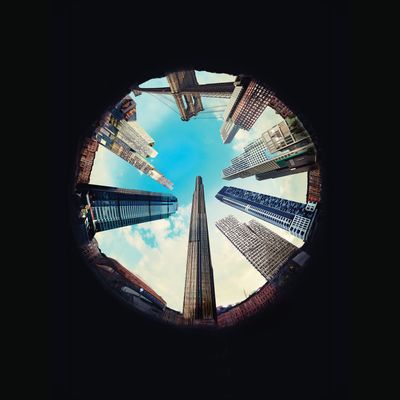
New York grew by dint of ugly architecture. Every celebrated skyscraper rose amid bundles of mid-rise mediocrity. Each masterpiece-producing boom also threw off acres of stupefying repetition. So it’s hardly shocking that a decade of high-rise construction in Brooklyn has brought forth a parade of buildings that an iPhone app could spit out. The ax blade of residential high-rises that slices the borough drives from Brooklyn Bridge Park through Downtown, grazing Fort Greene and reaching into Prospect Heights. Canyons of cheap window walls and protuberant air conditioners rise along Flatbush Avenue. Call it the Brooklyn Wedge, a nowhere that’s convenient to everywhere. It’s hard to fathom how sentient beings could have devoted so much time, money, and enthusiasm to producing such drear. Well, not that hard: Everyone follows the path of least resistance and then moves on to the next job. The result is an orgy of indifference.
When a newcomer does sport a dash of design, it only accentuates the sadness. Consider Brooklyn’s temporary tallest, 100 Willoughby Street, a.k.a. AVA DoBro, which SLCE Architects “designed” for AvalonBay. The architects speckled the façade of this monolithic mass in an assortment of blue panes, so that it looks as though the builders had raided an odd-lot store. Blue-glass patchwork has become a mystifying New York trend. Bernard Tschumi started it a decade ago with his bulbous Blue condo on the Lower East Side. Christian de Portzamparc followed up with his gaudy 57th Street supertall, One57. Here, it looks like a cheap knockoff of a bad idea.
The Wedge is the partially intended consequence of a plan to revive Downtown: A couple of decades ago, the area cleared out at the end of the business day and the full-time population numbered in the dozens. Then the Bloomberg administration rezoned Downtown in 2004, hoping to stimulate more office space. That didn’t materialize, but apartment towers did. Scan the provisional skyline, and you’ll see nearly 7,000 apartments that have gone up in the past ten years. Make note of the empty lots and work sites, and you can count 6,000 more already under construction. Add in projects at various stages of planning, and you see that the next decade will bring 6,000 more.
These new multitudes may yet bring redemption to the Brooklyn skyline, even if it’s slow, fitful, and incomplete. They will demand new restaurants, supermarkets, bookstores, and schools — and they’ll have to keep demanding for a while. Retail lags; public services lag even further. Eventually, though, when the construction fences go away, the streets will start to knit themselves together.
Improving the skyline begins at the street, and here, too, much-needed civic care is on the way. Is there any part of the city that makes moving around it so unpleasant? Even before the boom began, traffic was monstrous and the sidewalks moribund. Now construction fences push pedestrians into the road. Blocks of blank walls separate the few tempting storefronts. Outside of MetroTech’s corporate courtyard, the chopped-up green spaces seem designed to lure pigeons and deter people. Driving along Flatbush Avenue is a slow-mo contact sport, cycling means sparring with buses, and even crossing a street requires a reckless spirit. The city, the state, and the Downtown Brooklyn Partnership have spent years plotting how to fix the chain of parks and plazas shattered by the BQE, and now, maybe, their proposals have a chance.
You’d be justified in believing that block-hogging high-rises inevitably choke off street life. But a thoughtfully designed private tower can foster public life at its feet. TEN Arquitectos’ nearly completed 300 Ashland Place, flanking BAM and the Willamsburgh Savings Bank, gets it right. Developed by the Dumbo-based Two Trees, the metal-clad slab makes the most of its triangular site by declining to fill every corner. Instead of crowding its neighbors, it steps graciously away, perching atop a pile of public amenities: a library, three stores, four brightly painted BAM movie theaters jutting toward their mother opera house, a floor of dance studios, an outdoor staircase for lounging on, and a paved plaza. It’s designed to do more for the neighborhood than just maximize rentable square footage. The movie crowds will arrive just as the library closes, BAM audiences will have a pre-curtain place to mingle, and residents on their way home will run a gauntlet of culturati.
As the Wedge matures, time and rising real-estate prices are also pulling up the architectural baseline. Even SLCE, the firm that perpetrated AVA DoBro, expended more effort on its next-door neighbor, 388 Bridge Street. That glass-sided pillar, with its pet-rinsing station, two gyms, and imperial views, seems like a pleasant-enough place to live, and at least it doesn’t give blah a bad name. Two blocks away, the immense City Point complex has sprouted a pair of fraternal towers by CookFox, a large, relatively luxurious one and a stumpier, mostly affordable sidekick. Neither is beautiful, but they have virtues: a shopping concourse, including a Trader Joe’s, and the future Willoughby Park across the street. Even the lawsuit-afflicted Pacific Park next door to Barclays Center will soon yield some decent and affordable places to live: SHoP Architects’ 461 Dean Street, which sports more attitude than grace. Stacking and bolting together factory-made modules was supposed to make affordable housing cheaper and quicker to put up. Instead, construction snafus and lawsuits among builders turned the process into a nasty slog. Now the tower has defiantly announced its arrival with a façade of fire-engine red.
But the clearest sign that the Wedge is evolving past its frontier days is the future tallest building in Brooklyn. SHoP’s 1,000-footer at 9 DeKalb Avenue will be one of the most sensitively detailed and spectacularly expressive additions to the New York (not just Brooklyn) skyline since the Seagram Building. Some towers grab height; this one earns it.
Like most great urban architecture, the design emerges from a thicket of local constraints. The scarcity of lots and the difficulty of assembling them force architects and developers to be creative. SHoP plans to squeeze its 73-story spire on a triangle it shares with an unofficial landmark, Junior’s, and the officially designated Dime Savings Bank. The bank, originally designed by Mowbray and Uffinger in 1906, expanded in 1932 into a geometric layer cake: a round cupola on a hexagonal base, enclosed by another hexagonal banking hall, inscribed in a triangular site. SHoP’s designers extended the same grid onto the adjacent lot and massaged it into a composition of overlapping hexagons that get smaller on their way to the top, like a bundle of pencils of varying lengths. From below, the arrangement evokes an abstracted sandstone butte scored by erosion. A few steps back should bring the building’s New York–iness into focus. SHoP is one of the few forward-looking firms eagerly reviving New York’s old textures, colors, and materials. Tubes of varied sizes and profiles run up the exterior like organ pipes, growing thicker and darker as they shoot into the sky. An assortment of dramatic flourishes — the chiaroscuro of blackened metal and brazen glints, the Batman-ready ledges, the syncopated rhythms of windows — add up to a new kind of Gotham gothic.
None of these charms will placate Brooklynites who fear that giants are trampling the borough’s icons. When 9 DeKalb opens, its thin-air penthouses will look out over a four-to-eight-story metropolis stretching from Newtown Creek to Coney Island. So what is to prevent one superscaled building from leading to the next, until they invade the leafy brownstone shires? Plenty, for now: zoning regulations, the distribution of subway lines, the existence of historic districts, and the power of money to fight money. These barriers can leak and crumble, though, and so the best way to preserve low-rise Brooklyn is for the Wedge to succeed by growing up rather than out. A great skyline remains concentrated and confined, its towers made meaningful by borders, its scale a contrast to be savored, not feared.
*This article appears in the May 30, 2016 issue of New York Magazine.






























